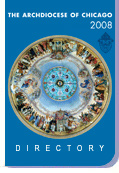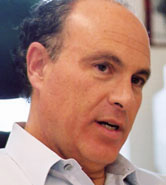 |
 |
|||||
 |
 |
 |
 |
 |
|||
 Archbishop Jean Sleiman: “When you kill someone else, even if you are defending yourself, even if it is legitimate, you kill something in yourself. War creates new problems.” Catholic New World photo /David V. Kamba A regular feature of The Catholic New World, The InterVIEW is an in-depth conversation with a person whose words, actions or ideas affect today’s Catholic. It may be affirming of faith or confrontational. But it will always be stimulating. . |
July 18, 2004
Saving lives by changing social expectations “Stop. Killing. People.” It’s hard to miss the red, white and black bumper stickers and posters blanketing several of the Chicago area’s most violent neighborhoods. For five years, the Chicago Project to Prevent Violence has been using a public health model aimed at changing behavior to try to reduce the number of shootings in selected Chicago-area neighborhoods. The program, known as Project CeaseFire, treats shootings like a public health problem rather than a law enforcement issue, and has achieved a consistent 45 percent drop in homicides in the neighborhoods they work in. Funded by a combination of private foundations and government sources, the organization says it has saved the public more than $36 million in medical and law enforcement costs by preventing shootings since its inception. Reducing violence is part of the social justice mission of the church, directly related to the dignity of every human person, and it has become one of Cardinal George’s key efforts. Executive Director Dr. Gary Slutkin, a professor of public health at the University of Illinois at Chicago, discussed the state of the project with Catholic New World staff writer Michelle Martin. The Catholic New World: What’s going on now with CeaseFire? Dr. Gary Slutkin: This year, 2004, we expanded from six to 16 communities. We have 70 outreach workers on the street now, and we have three miracles in 2004 from this expansion. In April, in the 11th police district (in West Garfield Park), we had zero homicides. No one thinks that’s ever happened before, even in a slow month. They average about 75 killings a year. Then in all of April, all of May and half of June, we went without a homicide in Maywood, the whole town of Maywood. That’s a brand new program. In Logan Square, which was the worst beat in the city last year—that’s a Hispanic area—-we have had no homicides at all this year. We went from having two full-time and two-part-time outreach workers there to 10 full-time this year. TCNW: How does the program work? DGS: It uses basic behavior change methods, methods that we’ve used for other fields of work. Behaviors are mostly driven by expectations. For example, you’re not smoking a cigarette in here because people don’t expect to smoke indoors anymore. It used to be different; it used to be acceptable. No one is really making, when you get right down to it, individual decisions. Most of the decisions are surrounded by social pressure. That what we call norms, what we think is normal. So if you grow up and you think it’s normal to shoot a gun when, whatever—he took my money or he insulted me or left the party early—it’s normal and acceptable and you do it. If it’s not normal and acceptable, then you don’t. Our job is to change what’s normal. You use multiple messengers with the same message. Our messengers include outreach workers and clergy and the community as a whole, meaning residents, and these public education materials. These four messengers are all saying the same thing: no shooting, we don’t shoot here anymore, it’s not acceptable, shooting makes things worse. The risk is not just that you’re going to get arrested or go to jail—it’s also a social risk. That social risk is displayed by the outreach workers and the residents, who keep getting in your face. “What the heck are you doing?” That’s new. TCNW: Where do the churches come in? DGS: The churches provide outreach, they provide safe havens, they participate in the responses and they provide community leadership. They also add a strength of legitimacy to the effort. There are 170 clergy who have signed on to the “Covenant for Peace and Action.” Originally, it was 70, when this was initiated by Cardinal George in September of 1999. Every three to four months since then, we meet with the clergy either for motivation or review or training—usually a combination of all three. We have 40-45 clergy who are very active. TCNW: Who are the outreach workers and what do they do? DGS: The outreach workers are from the communities, and they are mostly people in their 20s to 40s, and they’re mostly from the life itself. Many of them have past histories of gang involvement or prison, but they’re on this side of the line now. These 70 outreach workers have more than 900 high-risk clients. They’re dealing with those who are actively involved right now to get them to change their thinking mid-course. The other part of this is providing alternatives. It’s commonly mentioned that people need alternatives, meaning they need jobs and they need to go back to school and get a GED. Of course. We’ve gotten 300 or 400 people back into school. But a lot of people know how to do that. What we’re talking about is an alternative to shooting. It’s, at this moment, what am I going to do? Everyone’s riling me up, and there’s pressure, and they’re expecting me to shoot. What they can do instead is call CeaseFire, or their friend can call CeaseFire. We get these calls all day long every day, to resolve conflicts, to cool everybody down, to help them think better about what they’re about to get involved in. For example, we had somebody whose sister was shot. Of course, he’s going to try to get revenge and retaliate. That’s one of the bigger “of courses.” Our workers were out there talking with him and his friends: “Don’t you see how this is going to make it worse? Your mom is already completely upset. We don’t know what’s going to happen to your sister. Now you’re going to get yourself in trouble too? How’s that going to be for your mom? She’s going to lose both of you. Don’t you have kids?” It isn’t a simple discussion—everyone’s screaming at everybody. But they ended up listening and going over to the hospital and praying for her, and she ended up doing all right. It’s a lot of talking to people one by one and in groups so that a bunch of events don’t happen—we’ve prevented at least 350-400 shootings that we’ve documented, and by the numbers of what you would have expected. But it has to add up to more than the numbers, to this group now thinking differently. This is where we get to the tipping point, where people think there’s a different way to do it. Then the norm has changed. TCNW: How important has the cardinal’s involvement been? GS: He’s done a lot for the project, He has motivated a lot of our community residents. He’s been out at a lot of community events. He’s had breakfasts at his residence with civic and corporate leaders to inform of what CeaseFire is accomplishing to get their financial and other backing. The cardinal has come out to lead marches probably a half a dozen times. The cardinal has met with gang leaders to negotiate peace. He has actually privately sat with them, talked with them, and I saw, prayed with them, to shift their being, shift their thinking. The cardinal kicked off the whole clergy piece of the program, getting the commitments from the first 70 clergy. It took me two years to get into the cardinal’s office. But then when I got into his office, he had done so much research, he knew my background and he knew what we were doing. I had two requests, and he answered yes to both before I could finish the questions. I asked him to be an honorary chair and to host something at his house. We had a lot to talk about, because we had shared experience. We were both from Chicago, and had left for a long time. I was away for about 20 years. We came back at about the same time. For much of the time, we were both overseas. He was based in Rome, doing a lot of evangelical work in Africa, and I was also based in Europe, in Geneva, with the World Health (Organization) headquarters, and also traveling all over Africa, mostly with the AIDS epidemic. We saw the U.S. differently, and we saw Chicago differently. We had both been grounded by 10 years plus overseas. TCNW: How did you see Chicago differently? GS: Chicago is a city that really perceives the race issue as an issue of blacks and whites, or blacks, whites and Hispanics. It’s always “and Hispanics.” If you’re here most of the time, you could think “How could it be seen any other way?” Most of the world is not black or white. It’s much more mixed, it’s much more diverse than just two groups or three groups. It’s extremely limiting. When I was at World Health, I had a team of 40, and I had the world. Another thing is just how you see America. The cardinal really hits it when he talks about the U.S. being individualistic. Everyone is into themselves. We all know we are. But we don’t even have a lot of examples of not being like that. The whole mythology is that everyone makes it on their own, but that’s simply not true. You get a lot of help from your parents or from a teacher or someone else. It’s a lie that you make it on your own. Here we talk about community and try to figure out what it means; in Africa and Asia and other places, they don’t have to talk about it. They are it. Here, most of us don’t even know our neighbors. The result is isolation. When you have isolation, you have loss of trust, then you have fear, then you have responses to that fear. That’s the way individuals act here; that’s the way the country acts in relation to the world: individualistically, in an isolated way, based on fear. TCNW: Now that you’ve explained why we’re in Iraq … GS: Absolutely. We’re worried about our own oil, or we don’t want someone else to get it, or we don’t think they can do it … on and on and on. For more information, visit www.ceasefire.org or call (312) 996-8775 or (866) TO-CEASE |
||
|
|
|||